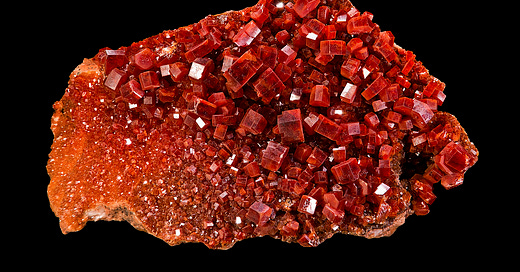Vanadium: Another Commodity Shortage Incoming?
We’ve all heard of the story of lithium and its use in battery technology for electric vehicles. Vanadium and its importance in future battery technology are not heard of anywhere near as much.
This is a remarkably prescient issue today as we see electricity grids labouring under poor planning, worse execution, and ageing infrastructure with the inability for realistic solutions (nuclear, hydrocarbons) to be implemented either through political will or ineptitude.
This post is a quick primer on vanadium for those interested in the commodity space. We are already seeing the realities of commodity scarcity dawning on the world. The dynamic of the vanadium market will be the same, both due to demand-side pull and supply-side constraints. It is also a secondary play on geopolitics – China will again benefit from its dominant position in this commodity. No doubt the West will continue to scramble once realisation dawns on it as it has previously with rare earths, microchips, general manufacturing and supply chains, and so many other critical day-to-day issues we used to take for granted.
Heads; Vanadium technology is embraced with China as a friend, and its domestic players win.
Tails; China is escalated to evil foe by the West, and its players still benefit from custom with an increasingly pragmatic and realistic Global South – nations that crave the electricity we in the west take for granted every day…for now.
In both circumstances, the western vanadium players will also benefit from the uptake of vanadium battery technology.
Vanadium Redox Flow Battery (VRB) Technology
This short video is a good primer on the benefits of VRB technology for grid-scale storage
Long lifespan cycles: the ability to repeatedly charge/discharge more than 35,000 times over a 20-year lifespan.
100% depth of discharge without material performance degradation is unique to VRFBs.
Low cost per kWh when fully used at least once daily.
Safety: no fire or smoke risk from thermal runaway.
Sustainability: a 30% lower carbon footprint than Li-ion batteries. Vanadium is reusable on decommissioning of a system.
The flexibility allows for capturing the multi-stacked values of energy storage in grid applications.
No cross-contamination, since there is only one battery element, unique among flow batteries.
Electricity’s share of global energy consumption has doubled from 10% in 1980 to 20% today. It is expected to exceed 40% by 2050. At the same time, renewable energy is displacing fossil fuels in energy generation. These two changes have enormous implications for global energy production and all minerals involved in the electricity value chain. Electricity is much more difficult to “store” than other energy sources.
Global annual deployments of VFRBs are expected to reach approximately 32.8 GWh per annum by 2031 according to research by Guidehouse Insights.
Broad Vanadium Market Brushstrokes
92% of global vanadium consumption is for steel input. Adding as little as 0.1% vanadium increases steel strength by up to 100% while reducing the weight of the required steel by up to 30%. Vanadium has remarkable characteristics which give it the ability to make things stronger, lighter, more efficient and more powerful. Creates ultra-high-strength and super-light alloys.
68% of vanadium production comes from China (net exporter but probably not for long) and Russia (net neutral) - as a byproduct of steel production. Russian production will still make its way to market in a roundabout way as its other commodities do.
The use in steel continues to increase with a 7.9% CAGR in consumption (and that's with 92% of demand still coming from steel alloy use and only 1% from VRFB batteries). The steel industry in China has been increasingly relying on imported iron ore, which is non-vanadium bearing. Over the longer term, Chinese vanadium production will be constrained by the decline in domestic iron ore supply and iron ore quality, coupled with environmental restrictions on steelmakers, co-product and stone coal vanadium producers, and the ban on vanadium slag imports.
Chinese government's efforts to rationalise its steel industry and cut pollution may impose further constraints on vanadium co-production steel plants. Stone coal production, meanwhile, will continue to be limited by environmental restrictions. The result is a constrained growth outlook for Chinese vanadium production from co-producers already operating at near capacity and stone coal vanadium producers. The ban on vanadium slag imports into China exacerbates the constraint.
Vanadium demand for use in rebar (reinforcing steel used as rods in concrete continues to increase at 6% annually.
Vanadium’s benefits to a greener society include its contributions as an alloy in high-strength, low-alloy steels primarily used in construction. Developing new titanium alloys continues with grades containing 8, 10 and 15% vanadium. They have the potential to make important contributions to weight reduction and fuel efficiency in aircraft of the future.
New markets are emerging and scaling up. These markets will increase vanadium demand further as it becomes more widely used in automotive, aviation, aerospace, renewable energy, power lines and pylons. Increasing demand from the ESG crowd (batteries) could prove enormous.
Suppose new uses of vanadium grow faster than steel demand, such as from energy storage. In that case, more primary vanadium production is required, and the price will rise as the supply imbalance increases. According to Roskill, vanadium demand from VRFBs will grow at a CAGR of approximately 56.7% through 2030. Longer-term demand will be even greater. For example, the World Bank Group forecasts that by 2050 vanadium demand from energy storage alone could be twice as large as global vanadium production in 2018.



